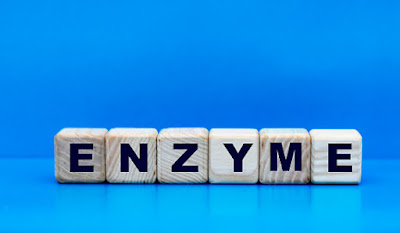enzymes
enzymes are biological catalysts which speed up the reaction rate without actually getting involved with the reaction itself.
examples of enzymes
celebra. amylase. pepsin.renin.lipase. catalase. isomerase. phosphorus.maltose.lactase.sub trace.types of enzymes
carbohydrates - digests the carbohydrates. [ eg Salivary amylase ]protease - digests the proteins. [eg pepsin] lipase - digests the fats.[eg enzymes from the pancreas]how an enzyme works?
an enzymehas an active site similar to the shape of a substrata.
when the enzyme comes into contact with the substrata it fits like a jigsaw and exerts pressure onto the substrate at a specific point so that it breaks up into simpler substance.the properties of enzymes.
all enzymes are proteins
all enzymes work best at a specific temperature known as the optimum temperature.enzymes get denatured [ lose shape of their active site ] if its optimum temperature is exceeded.
enzymes work the fastest at a specific pH level and like temperature get denatured when the pH exceeds the optimum.enzymes are specific in nature. [ they can only break down a specific substrate ]
factors affecting enzymes.
temperature as the temperature of a reaction mixture increases the kinetic energy inside the reactant particles increases as well.
this leads to a high collision frequency
to build up.this causes the substrata and the enzyme to collide more frequently and thus increases the rate of reaction.
however at a certain temperature.
the enzyme loses the shape of its active site resulting in the rate of reaction drastically falling.
pH
the pH for any enzyme to work depends upon its environment of production.
for most enzymes in the human body the optimum pH is 7 neutral.
however there are a few exceptions such as pepsin the enzyme that works in the stomach where dilute hydrochloric acid is secreted and the pH is as low as 2.
enzymes can work at pH slightly higher or lower than their optimum pH.using enzymes
uses in biological washing powders.
in order to break down organic substances such as carbohydrates proteins and fats [ that chemical detergents failed to break] such biological catalysts are used.
organic stains such as blood oil butter egg etc.are broken down to simpler substances inThe presence of protein assists.enzymes need to have an optimum temperature of at least 70 degrees Celsius and hence are extracted from thermophilic bacteria or bacteria living near hot springs to remove the other components of the dirt and so that other parts of the detergent work as well.the enzymes found in these bacteria are majorly proteases and lipidsease.
in order to keep these biological catalysts away from the skin contact [ as proteases can to digest skin cells made up of protein] they are packed in microscopic packets that only dissolve in the presence of water.uses in the food industry
foods contain a substance known as pectin that is present within the primary and secondary cell walls of the fruit cell.in industrial fruit juice extraction an enzyme called a pectin ace is used to break down the pectin present so as it is easier to squeeze the juice out.
this relatively increases the volume of juice extracted and thus makes it economical for the company.other than fruit juices enzymes are also used in baby food production where the food is treated with proteases and carbohydrates to break it down to simpler substances.
this helps the baby's body to easily absorb the food with indigestion prevented another use of enzymes is in sugar syrup production where amylase is used to break down starch to the sweet tasting disaccharide maltose this is the.





0 Comments